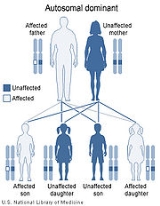
Central core disease
Encyclopedia
Central core disease also known as central core myopathy, is an autosomal dominant congenital myopathy
(inborn muscle
disorder). It was first described by Shy and Magee in 1956. It is characterized by the appearance of the myofibril under the microscope.
(decreased muscle tone) at birth, mild delay in child development
(highly variable between cases), weakness of the facial muscles
, and skeletal malformations such as scoliosis
and hip dislocation
.
(tissue sample) from muscle. The name derives from the typical appearance of the biopsy on light microscopy, where the muscle cells have cores that are devoid of mitochondria
and specific enzyme
s.
Respiratory insufficiency
develops in a small proportion of cases. Creatine kinase
and electromyography
(EMG) tend to be normal.
 Central core disease is inherited in an autosomal dominant fashion. Most cases have demonstrable mutations in the ryanodine receptor type 1
Central core disease is inherited in an autosomal dominant fashion. Most cases have demonstrable mutations in the ryanodine receptor type 1
(RYR1) gene, which are often de novo (newly developed). People with CCD are at risk for malignant hyperthermia
(MH) when receiving general anesthesia.
Congenital myopathy
Congenital myopathy is a term for any muscle disorder present at birth. By this definition the congenital myopathies could include hundreds of distinct neuromuscular syndromes and disorders...
(inborn muscle
Skeletal muscle
Skeletal muscle is a form of striated muscle tissue existing under control of the somatic nervous system- i.e. it is voluntarily controlled. It is one of three major muscle types, the others being cardiac and smooth muscle...
disorder). It was first described by Shy and Magee in 1956. It is characterized by the appearance of the myofibril under the microscope.
Signs and symptoms
The symptoms of CCD are variable, but usually involve hypotoniaHypotonia
Hypotonia is a state of low muscle tone , often involving reduced muscle strength. Hypotonia is not a specific medical disorder, but a potential manifestation of many different diseases and disorders that affect motor nerve control by the brain or muscle strength...
(decreased muscle tone) at birth, mild delay in child development
Child development
Child development stages describe theoretical milestones of child development. Many stage models of development have been proposed, used as working concepts and in some cases asserted as nativist theories....
(highly variable between cases), weakness of the facial muscles
Facial muscles
The facial muscles are a group of striated muscles innervated by the facial nerve that, among other things, control facial expression. These muscles are also called mimetic muscles.-Structure:...
, and skeletal malformations such as scoliosis
Scoliosis
Scoliosis is a medical condition in which a person's spine is curved from side to side. Although it is a complex three-dimensional deformity, on an X-ray, viewed from the rear, the spine of an individual with scoliosis may look more like an "S" or a "C" than a straight line...
and hip dislocation
Dislocation of hip
Dislocation of the hip is a common injury to the hip joint. Dislocation occurs when the ball–shaped head of the femur comes out of the cup–shaped acetabulum set in the pelvis. This may happen to a varying degree. A dislocated hip, much more common in girls than in boys, is a condition...
.
Diagnosis
The diagnosis is made on the combination of typical symptoms and the appearance on biopsyBiopsy
A biopsy is a medical test involving sampling of cells or tissues for examination. It is the medical removal of tissue from a living subject to determine the presence or extent of a disease. The tissue is generally examined under a microscope by a pathologist, and can also be analyzed chemically...
(tissue sample) from muscle. The name derives from the typical appearance of the biopsy on light microscopy, where the muscle cells have cores that are devoid of mitochondria
Mitochondrion
In cell biology, a mitochondrion is a membrane-enclosed organelle found in most eukaryotic cells. These organelles range from 0.5 to 1.0 micrometers in diameter...
and specific enzyme
Enzyme
Enzymes are proteins that catalyze chemical reactions. In enzymatic reactions, the molecules at the beginning of the process, called substrates, are converted into different molecules, called products. Almost all chemical reactions in a biological cell need enzymes in order to occur at rates...
s.
Respiratory insufficiency
Respiratory failure
The term respiratory failure, in medicine, is used to describe inadequate gas exchange by the respiratory system, with the result that arterial oxygen and/or carbon dioxide levels cannot be maintained within their normal ranges. A drop in blood oxygenation is known as hypoxemia; a rise in arterial...
develops in a small proportion of cases. Creatine kinase
Creatine kinase
Creatine kinase , also known as creatine phosphokinase or phospho-creatine kinase , is an enzyme expressed by various tissues and cell types. CK catalyses the conversion of creatine and consumes adenosine triphosphate to create phosphocreatine and adenosine diphosphate...
and electromyography
Electromyography
Electromyography is a technique for evaluating and recording the electrical activity produced by skeletal muscles. EMG is performed using an instrument called an electromyograph, to produce a record called an electromyogram. An electromyograph detects the electrical potential generated by muscle...
(EMG) tend to be normal.
Pathophysiology

Ryanodine receptor
Ryanodine receptors form a class of intracellular calcium channels in various forms of excitable animal tissue like muscles and neurons...
(RYR1) gene, which are often de novo (newly developed). People with CCD are at risk for malignant hyperthermia
Malignant hyperthermia
Malignant hyperthermia or malignant hyperpyrexia is a rare life-threatening condition that is usually triggered by exposure to certain drugs used for general anesthesia; specifically, the volatile anesthetic agents and the neuromuscular blocking agent, succinylcholine...
(MH) when receiving general anesthesia.

